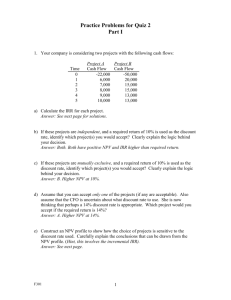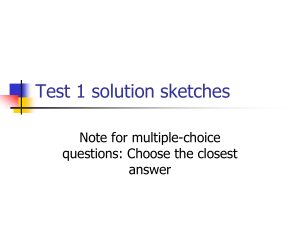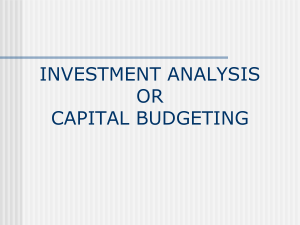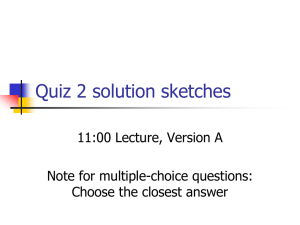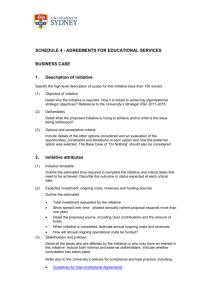Sample Questions in Exam 4
advertisement
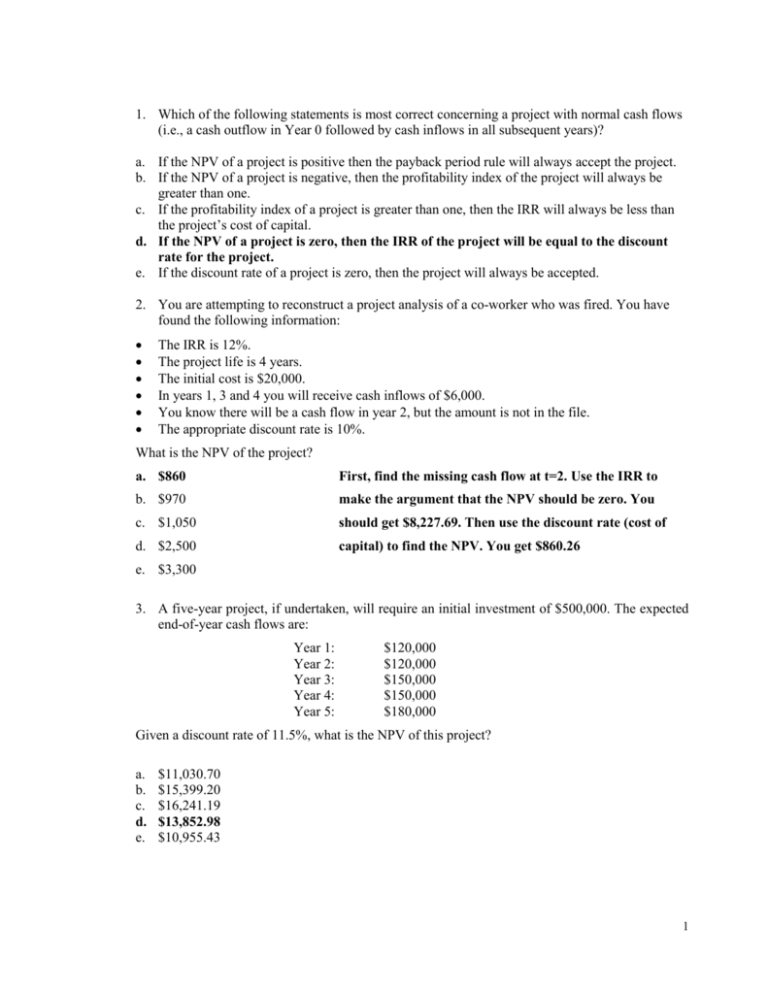
1. Which of the following statements is most correct concerning a project with normal cash flows (i.e., a cash outflow in Year 0 followed by cash inflows in all subsequent years)? a. If the NPV of a project is positive then the payback period rule will always accept the project. b. If the NPV of a project is negative, then the profitability index of the project will always be greater than one. c. If the profitability index of a project is greater than one, then the IRR will always be less than the project’s cost of capital. d. If the NPV of a project is zero, then the IRR of the project will be equal to the discount rate for the project. e. If the discount rate of a project is zero, then the project will always be accepted. 2. You are attempting to reconstruct a project analysis of a co-worker who was fired. You have found the following information: The IRR is 12%. The project life is 4 years. The initial cost is $20,000. In years 1, 3 and 4 you will receive cash inflows of $6,000. You know there will be a cash flow in year 2, but the amount is not in the file. The appropriate discount rate is 10%. What is the NPV of the project? a. $860 First, find the missing cash flow at t=2. Use the IRR to b. $970 make the argument that the NPV should be zero. You c. $1,050 should get $8,227.69. Then use the discount rate (cost of d. $2,500 capital) to find the NPV. You get $860.26 e. $3,300 3. A five-year project, if undertaken, will require an initial investment of $500,000. The expected end-of-year cash flows are: Year 1: Year 2: Year 3: Year 4: Year 5: $120,000 $120,000 $150,000 $150,000 $180,000 Given a discount rate of 11.5%, what is the NPV of this project? a. b. c. d. e. $11,030.70 $15,399.20 $16,241.19 $13,852.98 $10,955.43 1 4. Consider the following projects, for a firm using a discount rate of 10%: Project NPV IRR PI A $200,000 10.20% 1.04 B $200,000 11.00% 1.11 C $60,000 10.02% 1.01 D $(135,000) 9.00% .95 If the projects are independent, which, if any, project(s) should the firm accept? a. b. c. d. e. A, B only A, B, and C only B, C, D only A, B, C, and D None Use the following information to answer questions 23 to 25. Plastico Inc. manufactures a variety of plastic cases and distributes them to retail stores like Walmart. A survey conducted by the company revealed that plastic dvd cases are in high demand by consumers and not many companies currently manufacture this type of product. The company hired a consultant to determine whether or not they should undertake the manufacture of the dvd cases. He charged the company $120,000 for his services and provided them with the following information. The company currently has factories that are operating at full capacity and therefore they would need to build an additional factory on land that they own valued at $400,000. Machines and equipment would cost the company $500,000 and they would need to immediately increase their inventory of glue and other items by $100,000. The increase in net working capital will be recovered when the project ends in 10 years. The consultant estimated that they could sell 2 million cases at a price of $0.40 per case each year. The company could move some of their current employees over to the new plant. Their salaries cost the company $600,000 each year. Other operating costs not including depreciation amount to $300,000 each year. The company would have to take out a loan to finance the project and the consultant estimates that they would have to make interest payments of $60,000 each year to service the loan. He also estimates that they could sell the machine and equipment for $10,000 when the project ends. The company uses the straight line method to calculate depreciation and has a cost of capital of 10% and a tax rate of 40%. Record your final numerical answer to each of the following questions on the answer sheet. Show your work on the back of the answer sheet for possible partial credit. 2 What is the initial outlay at t = 0 for the project? ___$1,000,000__________ Land=$400,000; Equipment = $500,000; increase in NWC = $100,000 What is the t = 2 incremental operating cash flow? _$320,000__ R=2,000,000(0.40) = $800,000; Costs = 300,000; D = (500,000-10000)/10 = $49,000; OCF = (800,000-300,000)(1-0.40) + 0.4(49,000) = $319,600 What is the t = 10 incremental non operating cash flow? ___$110,000___ Recovery of NWC = $100,000; Salvage Value = $10,000. Total = $110,000 17. ABC, Inc is investigating a project with a projected year 0 cost outflow of $285,000, with projected annual net cash flows of $90,250 in Year 1, $89,450 in Year 2, $110,300 in Year 3 and $119,400 in Year 4. The company has a cost of capital of 10%. Compute the IRR of this project. IRR=15.31% 18. Project X and Project Y are two mutually exclusive projects. Project X requires an initial outlay of $37,990 and generates a net cash flow of $14,050 per year for six years. Project Y requires an initial outlay of $51,950, and will generate cash flows of $15,450 per year for eight years. Which project should be chosen and why? (Assume that the discount rate for both projects is 10 percent). NPVx=23,201.41 N=6, PV=-23,201.41, FV=0, I/Y=10, PMT(EAS)=5,327.21 NPVy=30,474.61 N=8, PV=-30,474.61, FV=0, I/Y=10, PMT(EAS)=5,712.28 Choose Y. 22. Consider a project with the following cash flows: Year t = 0 20,000 t =1 $3,500 t=2 t=3 t=4 $12,500 $15,000 $15,000 What is he Discounted Payback Period of this project? The appropriate discount rate is 11%. 3 cash flow PV cumulative PV t=1 3153 3153 t=2 t=3 10145 10968 13298 24266 (20000-13298)/10968=0.611 DPP=2+0.611=2.611 years Questions 23 - 25 are based on the following problem: SSC is considering the design and manufacture of a new line of products that will include a whirlpool tub. A market survey of current clients shows significant demand for such a product. SSC spent $250,000 doing this market survey, which the company believes has contributed significantly to their understanding of the demand for this new product, and the price that can be charged. The new product will require several sets of aluminum molds that will cost a total of $500,000. These molds will be depreciated on a straight-line basis to a $100,000 salvage value over 5 years. The new product will also require $1,000,000 for additional plant and machinery. Plant and machinery will be depreciated on a straight-line basis to a $200,000 salvage value over 5 years. The molds and all plant and equipment will be sold at the end of year 5 for salvage value. Manufacture of the new products will require a $150,000 increase in net working capital, which will be recovered at the end of the life of the project. All money for this project will be borrowed from a bank and the annual interest cost on the loans is expected to be $120,000 per year for each of the next 5 years. SSC estimates that they will sell 3,000 whirlpool spa showers in each of the next 5 years. Each unit is projected to sell for $1,000. Variable costs, excluding management salaries, are $500 per unit and incremental fixed costs for the manufacture these new units will be $450,000 per year for each of the next 5 years. The new whirlpool spa showers are not expected to have any effect on the demand or cost of existing units. The new plant and product will require the firm to hire 2 new managers at a total annual cost of $125,000 each. A third manager, also with a total annual cost of $125,000, will be moved from the existing product line to the new product line. The accounting department will allocate her cost to this new project. SSC’s tax rate is 40 percent. 23. Compute the initial net cash flow for this project. ____________ 24. Compute the Year 2 annual operating net cash flow for this project._____________ 25. Compute the final year non-operating net cash flow for this project. ____________ 4 Solution Initial net cash flow: Buy molds Buy new plant and equipment Increase in net working capital Initial Net Cash Flow - 500,000 -1,000,000 - 150,000 -1.650,000 Year 2 annual net cash flow: (^Revenue - ^Variable Costs - ^Fixed Costs - ^Salaries - ^Depreciation)(1-T) + ^Depreciation (3,000,000 – 1,500,000 – 450,000 – 250,000 – 240,000)(.60) + 240,000 = 576,000 Final Year Non-operating cash flow: Sell molds Sell plant and equipment Recover net working capital Final year non-operating NCF 100,000 200,000 150,000 450,000 5


